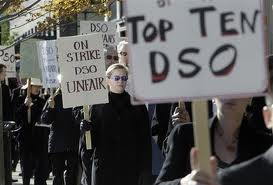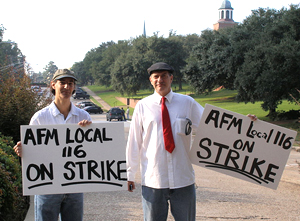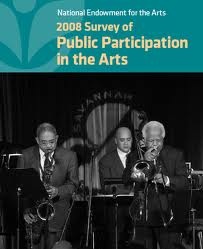American Orchestras: Yes, it's a crisis
“I am convinced that if the rate of change within an organization is less than the rate of change outside, the end is near.” – Jack Welch
In the last twelve months the Honolulu, Syracuse, and New Mexico Symphonies have filed for Chapter 7 Bankruptcy; the Philadelphia Orchestra and the Louisville Symphony filed for Chapter 11 Bankruptcy;  the Detroit Symphony suffered the longest strike in the history of America Orchestras, and the Cleveland Orchestra also walked out during a brief strike in January 2010. There are stories echoing across the industry of major problems at the Baltimore, Seattle, Atlanta, New York Philharmonic, and Minnesota Orchestras. Even the settlements made in Detroit and Cleveland have left these orchestras with substantial structural deficits and depleted endowments, with no clear plan how issues might be addressed, apart from the panacea of more fundraising. Clearly, the field is in crisis. It should be screaming for change, for new ideas. It should be discussing radical solutions.
the Detroit Symphony suffered the longest strike in the history of America Orchestras, and the Cleveland Orchestra also walked out during a brief strike in January 2010. There are stories echoing across the industry of major problems at the Baltimore, Seattle, Atlanta, New York Philharmonic, and Minnesota Orchestras. Even the settlements made in Detroit and Cleveland have left these orchestras with substantial structural deficits and depleted endowments, with no clear plan how issues might be addressed, apart from the panacea of more fundraising. Clearly, the field is in crisis. It should be screaming for change, for new ideas. It should be discussing radical solutions.
How on earth did all this happen?  How did the Philadelphia Orchestra, for instance, end up with a structural deficit of $14.5 million against an annual budget of $43.6 million and a pension liability of $43 million?
How did the Philadelphia Orchestra, for instance, end up with a structural deficit of $14.5 million against an annual budget of $43.6 million and a pension liability of $43 million?
Let’s go back in time and take a considered view. (Here, I’m indebted to the 2007-8 study done by Robert Flanagan of the Graduate School of Business at Stanford University. Click here to read the full, fascinating report.)
The early orchestral organizations in the U.S. were created very much in the co-operative spirit that we find at the London Symphony and Berlin Philharmonic (both orchestras were subjects in my two last blogs).  Musicians were seen as stakeholders and as members. They chose the conductor, accepted a share of net proceeds, as well as sharing in the risk. These musicians were true entrepreneurs and divided their time between artistic and management activities. Major donors started to take an interest and invest substantially in order to cover operating deficits, to provide stability and expand activities.
Musicians were seen as stakeholders and as members. They chose the conductor, accepted a share of net proceeds, as well as sharing in the risk. These musicians were true entrepreneurs and divided their time between artistic and management activities. Major donors started to take an interest and invest substantially in order to cover operating deficits, to provide stability and expand activities.
Unionization became a strong shaping force with the creation in 1962 of ICSOM (the International Conference of Symphony and Opera Musicians), which affiliated with the American Federation of Musicians in 1969.  Through such collective representation, musicians sought greater job security, guaranteed work, and benefits. They were aided in this quest by the Ford Foundation which, in 1965, began making extraordinary grants to orchestras ($85 million to 61 recipients) to improve the working conditions for musicians—a gift that arguably had long-term, if unintended, negative consequences. Subsequent contract negotiations transformed the musicians’ jobs into positions governed by Collective Bargaining Agreements that converted compensation packages from a variable to a fixed cost. (The financial model of any orchestra in the country today will show the musicians as the biggest single cost.)
Through such collective representation, musicians sought greater job security, guaranteed work, and benefits. They were aided in this quest by the Ford Foundation which, in 1965, began making extraordinary grants to orchestras ($85 million to 61 recipients) to improve the working conditions for musicians—a gift that arguably had long-term, if unintended, negative consequences. Subsequent contract negotiations transformed the musicians’ jobs into positions governed by Collective Bargaining Agreements that converted compensation packages from a variable to a fixed cost. (The financial model of any orchestra in the country today will show the musicians as the biggest single cost.)
Many people criticize the unions for causing the escalation of costs and, ultimately, the current dismal state of affairs. This is unfair because, at the end of every negotiation, two parties sign the agreement – management and the union, and it is management and of course the boards, that must take full responsibility. I once asked a senior and much respected orchestra president how on earth the field ended up with the restrictive contracts we have today. His response was resigned, “They were just better at negotiation.”
Since the late 1980’s, musicians’ compensation has increased more rapidly than the wages and salaries of white-collar, blue-collar, and service workers, with a particularly competitive rush across the top-tier orchestras throughout the 1990’s. This, in turn, has fueled musicians’ major argument at negotiations that any erosion of comparative salaries will negatively affect recruitment and retention. This is, of course, a specious argument, but it still goes unchallenged.
With spiraling fixed costs and little flexibility to increase productivity (the working week is eighteen hours with a maximum of eight services), the rest of the symphony orchestra’s financial model came under extreme pressure. Back in the 1930’s, the top orchestras could cover 85% of their total budgets through earned income, with the rest at 60%. By the beginning of the 21st century, earned income for the top orchestras was in the 50th percentile, with other orchestras coming in between 45% and 52%. Today nearly all orchestras are in the 30th percentile. This is a reflection not just of the changes within the financial model but also the aggravating effect of declining audiences.
Since 1982, audience numbers have declined by 29% with the sharpest fall in the period 2002-2008, according to the  National Endowment for the Arts Survey of Public Participation in the Arts. To compensate for the decline in box office revenues, orchestras have placed even greater reliance on donations and endowment draws, a particularly tempting stratagem because of the strong growth in private support between 1987—2003. This, is turn, has totally muddled organizational relations and the financial model. It is now the fixed costs of the musicians that drive fundraising activity, and it is compensation enhancements that absorb any increases in fundraising, thus preventing the organization from contributing to its own financial stability. These factors, combined with the very bad habit of taking excess draws from endowment to meet budget shortfalls and exacerbated by the economic collapse of 2008, set in motion a perfect storm that undermines the whole field.
National Endowment for the Arts Survey of Public Participation in the Arts. To compensate for the decline in box office revenues, orchestras have placed even greater reliance on donations and endowment draws, a particularly tempting stratagem because of the strong growth in private support between 1987—2003. This, is turn, has totally muddled organizational relations and the financial model. It is now the fixed costs of the musicians that drive fundraising activity, and it is compensation enhancements that absorb any increases in fundraising, thus preventing the organization from contributing to its own financial stability. These factors, combined with the very bad habit of taking excess draws from endowment to meet budget shortfalls and exacerbated by the economic collapse of 2008, set in motion a perfect storm that undermines the whole field.
This is the reality. This is what needs to be accepted and discussed. Only then can a solution perhaps be found.
Since Boards bear fiduciary responsibility for their organizations, the question has to be asked: what has been their contribution to this situation? Where have they been during all of this? Well, lulled by ever-increasing private support for many years, they have been complicit in sanctioning excessive pay demands, agreeing to excess draws on endowment, and signing off on defined benefit plans which, down the road, became financial monsters of unfunded liability. Once private support began to decline in 2003, they found themselves hamstrung and more and more they are resorting to bankruptcy as a means of resolving intractable difficulties or, in the case of Chapter 11, creating “flexibility” for change.
And what about all of those great philanthropists and foundations which have been loyal for so long? I have been talking recently with some major donors and leaders prominent in the orchestra world not just about Philadelphia and Detroit but the field as a whole. I have learnt a great deal from these discussions. Donors are feeling fatigued by orchestras – the constant demands, the needs, “Bridge Funds” leading nowhere, the on-going and unresolved problems. They are questioning the role of “orchestra monoliths” whose consumption of a community’s philanthropic wealth is disproportionate to the value they produce. They are questioning musicians’ passivity within the symphonic organization and the community when, in fact, it is musicians’ leadership and initiative that will be needed to make real change happen. They are asking these questions with a degree of serious concern that should make everyone think creatively about relationship, structure, and community for the future. Why? Because these investors are rethinking their priorities.
There are no sustainable orchestral models in this country that the field can point to and emulate. There are a few isolated examples of individual success, but this success is the result of a unique set of circumstances that apply only to an individual community. I believe it is the European model that the U.S. can best learn from.  The great examples are the London Symphony and the Berlin Philharmonic. And don’t dismiss these models as not applicable because they receive some form of government subsidy. What matters is how orchestras make use of their resources—whether a government subsidy or privately raised endowment. What matters is how orchestras justify the support they receive, that is to say, their legitimacy in the community. As Alex Ross said in The New Yorker, “Every orchestra survives locally.”
The great examples are the London Symphony and the Berlin Philharmonic. And don’t dismiss these models as not applicable because they receive some form of government subsidy. What matters is how orchestras make use of their resources—whether a government subsidy or privately raised endowment. What matters is how orchestras justify the support they receive, that is to say, their legitimacy in the community. As Alex Ross said in The New Yorker, “Every orchestra survives locally.”
An orchestra’s legitimacy hinges on every facet of its organization, from its programmes to its community engagement efforts, from its Board representation to its behaviors and beliefs. Legitimacy is no longer conferred simply because an orchestra plays well. Yet, many orchestras are so inwardly focused, so resistant to new ideas and new models, so unwilling to question programmes that are way past their expiration date, that they inadvertently shut them out from the lives of their communities.
It is time for a thorough reexamination.
London and Berlin are all about reinvention and rejuvenation. Their musicians are empowered and are seen as major stakeholders. The old employer/employee relationship does not exist. The orchestras have reached out into their communities and engaged.  Engaged at the levels of schools and teaching teachers, engaged with social issues of immigration, engaged in a pro-active way in creative projects for kids working with inspirational musicians from their orchestra. The musicians govern; they are at the centre of planning, at the centre of strategy. The old autocracy of the Music Director doesn’t exist. The orchestra is not dependent on the sacred vision of one individual but on the collective energy of all musicians. Productivity and flexibility are high and costs are much leaner than top U.S. orchestras. And Berlin and London work with the best, having Sir Simon Rattle and
Engaged at the levels of schools and teaching teachers, engaged with social issues of immigration, engaged in a pro-active way in creative projects for kids working with inspirational musicians from their orchestra. The musicians govern; they are at the centre of planning, at the centre of strategy. The old autocracy of the Music Director doesn’t exist. The orchestra is not dependent on the sacred vision of one individual but on the collective energy of all musicians. Productivity and flexibility are high and costs are much leaner than top U.S. orchestras. And Berlin and London work with the best, having Sir Simon Rattle and  Valery Gergiev at their respective helms, but in defined, contained roles specific to individual projects. The Boards are streamlined fiduciary committees with musicians in the majority. Leadership has been redefined. The work of the orchestras is energized and contemporary. These ensembles have a sustainable future.
Valery Gergiev at their respective helms, but in defined, contained roles specific to individual projects. The Boards are streamlined fiduciary committees with musicians in the majority. Leadership has been redefined. The work of the orchestras is energized and contemporary. These ensembles have a sustainable future.
Can American orchestras let go of their outdated and orthodox models? Can they look over the horizon to other ideas? After all, we are all looking to them to maintain this great and wonderful art form, which we all love and wish to see flourish.
Postscript: Click here watch a panel discussion in which I took part on the subject of American Orchestras: Endangered Species. It was presented by New York’s WQXR on May 3.

[…] Woodcock gave us a classic example of the “dinosaurs falling from the sky” genre of industry analysis on this blog last week. […]
[…] Tony Woodcock: American Orchestras: Yes it’s a crisis […]